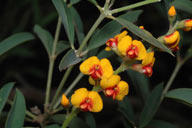In Flower This Week
A weekly news sheet prepared by a Gardens' volunteer.
Numbers before each plant refer to temporary IFTW labels in the gardens.
Numbers in square brackets [ ] refer to garden bed Sections. Plants in flower are in bold type.
View past issues of 'In Flower This Week'.
7 June 2013
Gastrolobium propinquum click for larger image |
On these cool sunny days it is refreshing to inspect the flowers in the Western Mallee Section, which contains plants from South and Western Australia. It is also a chance to view the construction of the new Red Centre Garden site. The walk starts at the Ducrou Pavilion on the Eucalypt Lawn.
- Edging the Red Centre site a native tobacco plant, Nicotiana rosulata subsp. ingulba, is dense with white flowers.
- Nearby Sturt’s Desert Pea, Swainsona formosa, continues to bear a few of its large dark-centred red pea-shaped flowers scattered among the rocks.
- Grevillea lanigera [Section 300] with pink-cream flowers is one of many groundcovers seen on the opposite side of the road.
- Edging this road, Melaleuca radula [Section 100b] is an upright shrub with terminal fluffy mauve flowers in clusters.
- A blue-bush, Maireana sedifolia [Section 100b], is a small plant with grey fleshy foliage, attractive though not flowering.
- An emu bush, Eremophila youngii [Section 100b], with rose‑coloured tube‑shaped flowers is seen here among other shrubs.
- At the corner Eremophila warnesii [Section 100b] is a small upright plant with velvety foliage and deep purple flowers.
- Behind this is Eremophila forrestii subsp. forrestii [Section 100b] with many pink-white tube‑shaped flowers.
- Entering the boardwalk, Eremophila christopheri [Section 100a] has mauve, almost pendulous tube-shaped flowers on the dense medium shrub.
- Gastrolobium propinquum [Section 100b] has tiny red-centred orange pea-shaped flowers on this spreading shrub.
- Adenanthos obovatus [Section 100a] is a small upright plant clad with red flowers having long red styles.
- Further along, Thryptomene denticulata [Section 100b] has low arching branches bright with tiny pink flowers.
- Rounding the corner Thomasia petalocalyx [Section 100a] has a sprinkling of pink downturned flowers.
- Continuing along this other side, Diplolaena grandiflora [Section 100a] has prominent orange-red flowers held in bracts.
- Banksia epica [Section 100a] is a shrub of medium size bright with many large rounded yellow flower spikes.
- Baeckea crassifolia [Section 100a] is well‑covered with tiny mauve flowers over the small many‑branched shrub.
- A wattle, Acacia alata var. biglandulosa [Section 100c], is a large shrub dense with long zig-zag flattened branches and with single cream fluffy flowers.
- Crowded beside is Hakea cycloptera [Section 100c], with needle‑like foliage and profuse with white lacy flowers.
- Hypocalymma jessicae [Section 100a] is of medium size with tiny pink flowers edging its many branches.
- Behind this shrub, Banksia heliantha [Section 100a] is of medium size with large terminal yellow flower heads.
- Astartea sp. [Section 100c] is an upright shrub of medium size bearing a profusion of white‑petalled flowers.
- At the exit Correa reflexa ‘Kangaroo Island form’ [Section 100a], also of medium size and crowded among other plants, has slim tubular red flowers with cream mouths.
- Close to the exit, Taxandria marginata [Section 100c] previously Agonis is a tall many‑branched shrub with terminal clusters of dark‑centred white flowers, seen best above the path.
- In the distance is a white holly, Auranticarpa rhombifolia [Section 96], a small tree bright with orange fruits.
Barbara Daly
![Director of National Parks [logo]](../../../../images/dnp_90px.gif)







